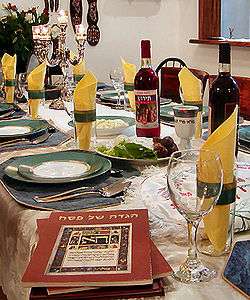Ha Lachma Anya

Ha Lachma Anya is a declaration that is recited at the beginning of the Magid portion of the Passover Seder. Written in Aramaic, the recitation serves as the first explanation of the purpose of the matzo during the Seder.[1]
History
Although portions of the Haggadah quote the Torah, scholars trace the origins of the Haggadah to the Talmudic era.[2][3] Specifically, scholars have identified two major versions of early Haggadot: an Eretz Yisrael version and a Babylonian version.[2] Modern Haggadot are based on the Babylonian version, the earliest complete copies of which are found in the siddurim of Rabbis Amram Gaon and Saadia Gaon.[4] Over time, Ashkenazic, Sephardic, and Mizrahi "sub-versions" developed; however, "there is relatively little difference in the basic text of the Haggadah within the descendants of the Babylonian versions".[5]
According to Rabbi Yaakov Lorberbaum's Ma'aseh Nissim, Ha Lachma Anya was first recited after the destruction of the Second Temple in Jerusalem; according to Maimonides, Ha Lachma Anya was not recited before the Temple was destroyed.[6] Shibbolei ha-Leket states that Ha Lachma Anya was instituted in Israel, while the Malbim and Ra'avyah trace the origins to Babylon.[7] David Arnow notes that some sources state that Ha Lachma Anya originated during the Gaonic period (circa 750-1038 CE), while others trace it back as far as the first or second century CE.[8] Some medieval Haggadot added the phrase "we left Egypt hastily" (biv'hilu yatsanu m'mitsrayim) at the beginning of Ha Lachma Anya.[8]
Procedure
During the Magid portion of the Passover Seder, participants retell the story of the Exodus from Egypt.[9] The Magid begins with the uncovering and lifting of the matzah on the Seder table and the recitation of Ha Lachma Anya.[10][11] The words Ha Lachma Anya are written in Aramaic,[12] and it begins with the proclamation that "this is the bread of affliction that our ancestors ate in Egypt".[13] This recitation is based on Deuteronomy 16:3, which states that "[y]ou shall eat unleavened bread, bread of 'ani' (distress) — for you departed from the land of Egypt hurriedly", and the recitation serves as "the first official explanation for matza in the Hagaddah".[1]
Invitation to guests
Abravanel teaches that "Ha Lachma Anya should be recited at the entrance to the house, with the door open, so that paupers can hear the invitation and enter".[6] Sol Scharfstein also notes that in times past, the head of the household would go out to the street to say Ha Lachma Anya, thus inviting poor people to join him at the Seder.[14]
Modern interpretations
Anisfeld, Mohr, and Spector have suggested that Ha Lachma Anya adds "a sense of immediacy and urgency to our telling" of the story of the Exodus, and that the recitation "establishes the intimacy of our connection to the ancient Israelites" because participants in the Seder will "eat the same bread they ate" and will "experience the taste and texture of their lives as slaves".[13] Zion and Dishon have also suggested that the reference to matzah in Ha Lachma Anya "is a memorial not of liberation, but of slavery".[1] Isaacs and Scharfstein have also stated that the process of beginning the Magid by looking at matzah "is a visual reminder of events in Egypt" and that the Ha Lachma Anya "also stresses the importance of opening one's house to the poor and sharing one's meals with them, because it is through such generosity that one can aspire to redemption".[12][14]
See also
References
Citations
- 1 2 3 Zion 1996, p. 37.
- 1 2 Tabory 2008, p. 2.
- ↑ Telushkin 2001, p. 643.
- ↑ Tabory 2008, pp. 2–3.
- ↑ Tabory 2008, p. 3.
- 1 2 Vilosky 2014, p. 55.
- ↑ Vilosky 2014, p. 54.
- 1 2 Arnow 2008, p. 135.
- ↑ "A Review of the Seder of the Seder". Orthodox Union. February 18, 2014. Retrieved April 7, 2016.
Over the matza and the second cup of wine, we tell of the Exodus in answer to children’s questions.
- ↑ Scharfstein 1999, p. 81.
- ↑ Isaacs 2000, pp. 82–83.
- 1 2 Isaacs 2000, p. 83.
- 1 2 Anisfeld 2006, p. 81.
- 1 2 Scharfstein 1999, pp. 81–82.
Bibliography
- Anisfeld, Sharon Cohen; Mohr, Tara; Spector, Catherine (2006). The Women's Seder Sourcebook: Rituals & Readings for Use at the Passover Seder. Jewish Lights Publishing. ISBN 1580232329.
- Arnow, David (2008). My People's Passover Haggadah: Traditional Texts, Modern Commentaries, Volume 1. Jewish Lights Publishing. ISBN 1580233546.
- Isaacs, Ronald H. (2000). Every Person's Guide to Passover. Jason Aronson. ISBN 0765760436.
- Scharfstein, Sol (1999). Understanding Jewish Holidays and Customs: Historical and Contemporary. KTAV Publishing House. ISBN 0881256269.
- Tabory, Joseph (2008). The JPS Commentary on the Haggadah: Historical Introduction, Translation, and Commentary. Jewish Publication Society. ISBN 0827608586.
- Telushkin, Rabbi Joseph (2001). Jewish Literacy. Harper Collins. ISBN 0688085067.
- Vilosky, Rabbi Chagai (2014). Pesach Haggadah: The Answer Is... (PDF). Art Scroll. ISBN 9781422614839.
- Zion, Noam; Dishon, David (1996). Haggadah Shel Pesach: The Family Participation Haggadah: a Different Night. Shalom Hartman Institute.